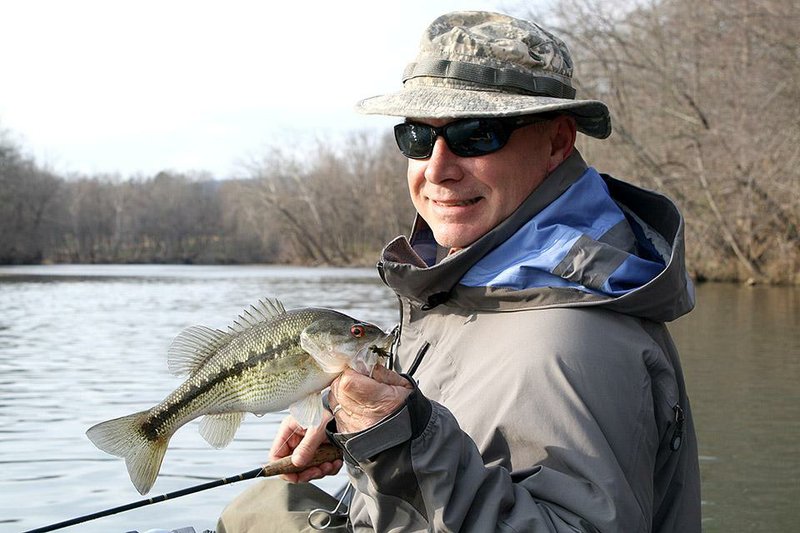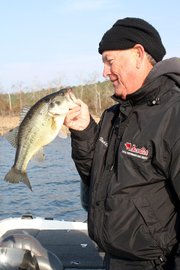While there is still a month of archery deer season and squirrel season left, many sportsmen are turning their thoughts to fishing.
If you can stand the cold, you can experience some excellent fishing around the state for anything that strikes your fancy. It's a great time to catch fat, healthy largemouth and smallmouth bass on lakes and streams. Stripers, hybrids and white bass are getting easier to find and easier to catch, and we are entering prime time for walleye fishing.
Now is also a fine time to catch saugers on the Arkansas River, and trout fishing is excellent on the White, North Fork and Little Red rivers. If you want a mess of the biggest crappie you'll catch all year, now is the time to get after them.
LARGEMOUTHS
Scott Rook of Little Rock, a Bassmaster Elite Series angler who will fish in the Bassmaster Classic on Feb. 19-21 in Greenville, S.C., said largemouth bass fishing can be excellent in mid winter if you'rein the right places.
Specifically, he recommended looking for stained water because sediment traps and holds heat better than clear water. He said bass orient to cover in depths of 10-17 feet, mentioning deep points next to creek channels.
Contrary to perception, bass eat a lot in cold water, but you have to go slowly to catch them. Probing a heavy jig-and-trailer or a plastic worm in tight cover can provoke strikes. If you find a school of bass suspended over a point or near a brush pile, you can catch them with a jigging spoon. Bass will hit crankbaits, too, but Rook said it's important to work it slowly.
"The fast-retrieve reels that are all the rage now are too fast," Rook said. "They take a bait out of the strike zone too quickly. In the winter, I don't use anything faster than a 5.4:1 reel."
SMALLMOUTHS
Summer makes for more comfortable floating, but winter is an excellent time to catch big smallmouths while float fishing on a mountain stream.
Every year about this time I float the Caddo River with Bill Eldridge of Benton and Rusty Pruitt of Bryant. We usually do the eight-mile section from Caddo Gap to Glenwood that contains some hard-to-navigate rough rapids, but big smallmouths lurk in the pools.
My biggest Caddo River smallie came in February 2012. It weighed nearly 4 pounds, and I caught it on a black/purple Yamamoto twin-tailed grub on a Texas rig. Eldridge caught several big ones last year near the confluence of the South Fork of the Caddo.
The technique isn't always slow, either. In 2011-2012, I caught successions of fat smallmouths on a topwater plug, an Excalibur Zell Pop.
To catch smallmouths on lakes, use a fat crankbait with a wide, exaggerated wobble on main lake points and secondary points. A Storm Wiggle Wart is my favorite. You also can catch them with suspending stickbaits.
Another method to catch suspending smallmouths is the float-and-fly. It consists of throwing a weighted nymph under a bobber.
A bobber stopper pegs the nymph at the proper depth. You also need a long, limber rod. Pop the rod tip to make the nymph dance in front of a suspending fish. Smallmouths are aggressive even in cold water, and they won't tolerate it.
STRIPERS/HYBRIDS
If you want to catch trophy stripers and hybrids, mid- and late winter are hard to beat.
Stripers are adapted to cold water, and they feed voraciously. Look for them in the upper reaches of Beaver, Ouachita and Bull Shoals and other similar lakes. Stripers in Lake Dardanelle aren't as big as those in the White River impoundments, but you can catch 5- to 10-pounders near the power plant discharge area.
As spring approaches, stripers move into main river arms of our big lakes in a false spawn. In fact, Shawn Miller, who held the state record for black bear, caught them in the upper Ouachita River in early January.
You can catch them with crankbaits and especially stickbaits, but don't be surprised to catch them on jigs. These battles can take place in some very narrow and shallow water, so the odds favor the fish.
Hybrids stay in the main bodies Hamilton, DeGray, Beaver and Greers Ferry lakes. Find them on a graph and work them over with jigging spoons a few inches off the bottom. You'll probably hook big fish, so check your line often for nicks and abrasions.
WALLEYES
Walleyes and stripers often run together this time of year. You can catch walleyes by trolling rainbow trout or firetiger stickbaits very slowly upstream in creek and river arms of big lakes.
You need light line and a light-action rod to get the bait deep enough and to impart the proper action. This can produce some drama because you are just as likely to hook a striper, and a big striper can destroy light tackle.
CRAPPIE
If you want to catch a limit of crappie this month, you'll be disappointed. If you want to catch a third of a limit of giant crappie, and if you don't mind spending half the day doing it, then February is your time.
Mark Hedrick of Little Rock is a devoted crappie angler, and he loves to hit Lake Maumelle in the winter.
"You might be out there all day and catch only five to seven crappie, but they are always big and healthy," he said.
Hedrick and Johnny Lewis of Little Rock recently had such an outing. Their two best crappie weighed nearly 2 1/2 pounds each. For that, Hedrick fishes about 35 feet deep with a 1/8-ounce jig on 4-pound test line.
"When you catch a fish like that on 4-pound line on a limber rod at 35 feet, it feels like a hubcap coming out of there," Hedrick said.
Hedrick tips his jig with a Zoom Tiny Fluke. He paints the sides pink and the tail chartreuse. The shade of pink depends on cloud cover and water clarity. Bright for low-light conditions, and more subtle shades for clear, bright conditions.
"I cast and count it down to 25 or 30 to where I think the fish might be," Hedrick said. "I swim it right up to where I think the brush is and kill it, then lift it up and keep going, fishing it as slow as you can fish it."
If you continually hook brush, it means there aren't any fish there, Hedrick said. If crappie are in the brush, they'll hit it before a jig has time to hang a limb.
TROUT
Trout bite anytime. Throw stickbaits around rocks in rising water to catch big browns. Fish real or artificial worms and grubs on dropper lines with a Dipsey sinker to catch rainbows.
Get your fill while you can. Turkey season will be here before you know it.
Sports on 02/01/2015

